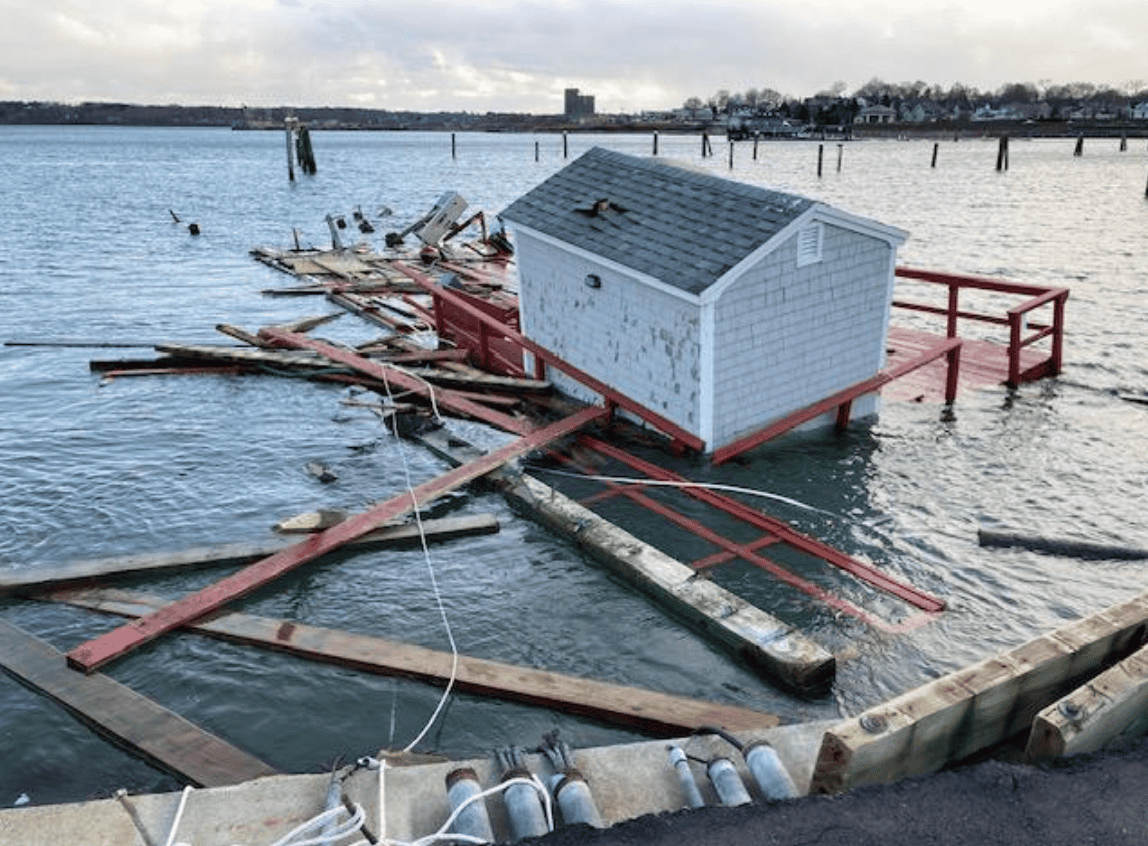It would be much easier to chronicle the historic dual storms of January 10th and 13th and yet another on March 10th by talking about those harbors on the Maine coast that were NOT damaged, which are few. Most harbors and working waterfronts took a significant hit. From Kittery to Cutler, very little escaped the carnage. While there is much work to be done surveying and estimating the damage, several initial estimates of $100 million dollars or more have been put forward. Over 500 waterfront businesses have already submitted preliminary damage assessments.
But let’s first stand back and get a perspective on what happened. On Wednesday, the 10th, the forecast was ominous. Hurricane-force winds from the worst possible direction (SE) at the worst possible time (an astronomical high tide).
The result was Portland’s third-highest water level ever recorded on Wednesday and widespread coastal damage.
The Saturday storm barely gave property owners and harbormasters a chance to recover before it all happened again. While the wind was slightly more east than on Wednesday, and the wind strength was down a bit, the tide was a foot higher, resulting in the highest water level ever recorded in Portland.
While it might seem easy to assume that these two events, plus the March 10th storm were just bad luck and not likely to be repeated, recent trends are a sobering wake-up call for us all.
Here are the facts according to CCA member James Bennett who has been researching extreme storm surge history in Camden.
Extreme Storm Surge Events in Camden, 1931 to present:
- Over an 86-year period from 1931 to 2017, there were 16 extreme storm surge events or 0.2 events per year on average.
- Over the past 6 years (2018 to 2024) there have been 11 extreme storm surge events or 1.8 events per year on average.
- An 900% increase in frequency in the last 6 years vs the prior 86 years.
A review of Camden and nearby Penobscot Bay follows:
Camden, Rockland and Penobscot Bay:
North Haven was front page news on the Maine Sunday Telegram as the community of 400 in North Haven came together to save the J. O. Brown Boat House where boats have been built and repaired since 1901. Only by a concerted effort by many of the town’s 400 year-round residents, was the iconic structure saved from total destruction. And to think that the total fetch from the southeast wind is only 1 mile.
Rockland also took a hit with the Landings Marina shattered.

Camden: Only two key waterfront facilities survived, having been recently raised and rebuilt. Lyman Morse’s entire waterfront campus was newly rebuilt two years ago and raised to a new more resilient elevation and it did well. Its dockhouse, however was pitched 100 feet north, bouncing off the fuel pumps, before it fetched up against a stack of docks.

The Town Landing was destroyed a year ago by storm waters and the new hardened and raised landing survived, but the parking lot was largely flooded and the floating docks nearly floated off their pilings.

The west (town) side of the harbor was a different story. The Camden Yacht Club was awash but interior damage was limited to the kitchen. The porch, south bulkhead and grounds were significantly damaged but the 110-year-old structure somehow withstood yet another assault, only to have early repair efforts reversed again on March 10.

Most of the west (town) side of the harbor was damaged as the seas swept over virtually all docks and into most buildings.
The venerable Waterfront Restaurant had knee-deep water in it and the deck was damaged. They were able to reopen February 2nd, but had another short closure after flooding occurred again on March 10.

The Harbor Square condo’s underground garage had water four feet deep in it and the entirety of the harbor side deck was eliminated.

At the head of the harbor, the beautiful harbor park granite bulkhead was overtopped and compromised and the lawn was significantly eroded.

In the outer harbor, five of the six fixed piers were demolished. One waterfront dock owner was fortunate in that after the destruction of his pier in December of 2022, he was not able to rebuild this past summer…it would have been destroyed again.

The town’s Steamboat Landing launch ramp was destroyed with large chunks of reinforced concrete tossed around like sticks of wood.

With the Gulf of Maine expected to rise 1.5 feet by 2050, and the frequency and severity of storms ever increasing, Maine’s working waterfront is facing some serious challenges. One cannot just repair what was damaged as these storms proved. The hardened and raised structures survived, structures rebuilt to their prior specifications were again destroyed.

It behooves all cruisers to reach out to those working waterfront stakeholders and offer whatever assistance you can. Island Institute is accepting gifts for Business Resilience work, focusing on the working waterfront businesses affected by the storms. The direct link to that dedicated fund is here: - choose Business Resilience in the dropdown menu.
In addition, Maine Coast Fishermen’s Association has set up a Working Waterfront Support Fund (maine-coast-fishermens-association.networkforgood.com).
The CCA Online Cruising Guide to Maine will be, as always, comprehensively reviewing and updating all covered locations and facilities to provide an accurate assessment of recovery as summer approaches.
We are adding Harbor Storm Updates in Red to pages as we learn the information. If you have an update to a harbor or anchorage, please share in our feedback form.


